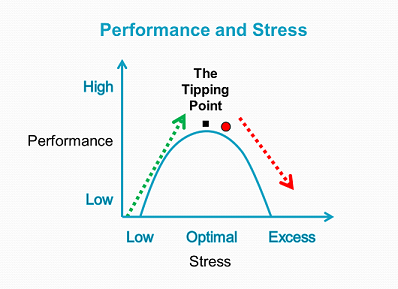When you walk in the room, who shows up for Read more →
The Tipping Point of Performance
Posted Thursday, August 23, 2012Allen Slade
I love sports movies, especially about underdogs. The critical moment is when the coach or loved one gets the underdog fired up. I love Rocky II, when Talia Shire lights Rocky’s fuse from her hospital bed and Remember the Titans, when Denzel Washington gives a moving call for unity in the Gettysburg cemetery.
As a leader, do you try to fire up your team? Be careful. If you play with fire, you can get burned.
Clearly, there are times when you need to establish a sense of urgency. But asking for extraordinary effort can backfire. As the performance curve below shows, there is an inverted-U relationship between stress and performance. A straight line relationship between stress and performance does hold, but only in the green zone.
 A leader who operates in the green zone can increase performance with stress. A complacent team may benefit from getting fired up. Stress triggers higher performance. The leadership situation has to be right: sufficient trust, basic equity and the capability to perform better. Given those things, adding some stress adds some performance. More stress creates more performance. This straight line relationship is a simple recipe for success: up the quota, accelerate the deadline, give the locker room speech or crack the whip and the underdog becomes the champ.
A leader who operates in the green zone can increase performance with stress. A complacent team may benefit from getting fired up. Stress triggers higher performance. The leadership situation has to be right: sufficient trust, basic equity and the capability to perform better. Given those things, adding some stress adds some performance. More stress creates more performance. This straight line relationship is a simple recipe for success: up the quota, accelerate the deadline, give the locker room speech or crack the whip and the underdog becomes the champ.
The problem hits at the top of the curve. When a person reaches the tipping point, more stress equals less performance. Further pressure for performance leads to a downward spiral in the red zone. People become anxious. They act indecisively, work slower or make more mistakes. As their performance decreases, their anxiety increases, further decreasing their performance. Notice the red marble at the top of the performance curve. In the red zone, the marble accelerates down the curve of poor performance. As a leader, if you push a person too far, their performance drops. And, their performance will continue to get worse because of the downward spiral.
Bottom line: Push for performance, but avoid the tipping point for stress. As Bob Rosen says, lead with just enough anxiety.
Aim for high performance, not peak performance. I coach leaders to avoid pushing people to their tipping point. If the tipping point is at 100% performance, aim for 90 or 95%. Then, your team member has a stress buffer. If there is a coffee spill that wipes critical data or a car wreck going to the big meeting, they will have the psychological reserves to get through it. If you push to get the full 100%, your people may tip into the red zone.
Develop your people. If you wish to increase performance, but a person is near the tipping point, think development first, motivation later. Increase their competence and capacity, so they can perform better while maintaining an essential stress buffer.
Be a lifeguard. Your people can drown in stress. The downward spiral of performance undermines decision making and behavioral flexibility. If someone is in the red zone, you may need be their lifeguard. Watch for signs of stress in your team members, watching for people at the tipping point or in the red zone. Then, throw them a life line. Offer more resources, renegotiate deadlines, offer them time off to refresh and rest. Be creative – think of the rousing speech that fires up the underdog, then do the opposite.
Know your team. Everyone is different. The people you lead have different capabilities and stress tolerances. They will show different warning signs of a stress-induced performance crisis. Get to know your people before a crisis. Have regular dialogue with every team member. Seek insight about their performance patterns, personal stressors and individual signs of overload. This will equip you to be a stress lifeguard.
Being mindful of the performance curve can help maximize sustainable performance for the people you lead. So go lead with just enough anxiety.


Pingback: The Glass Half Full | 8 Tips to Combat Stress